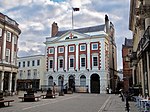16–22 Coney Street

16–22 Coney Street is a terrace of shops in the city centre of York, in England. The terrace was built in about 1500 as three timber-framed houses, with their gable ends facing onto Coney Street. In the 18th century, the windows were altered, and the front was plastered over. In the 19th century, a brick extension was added at the rear of 20 and 22 Coney Street. At that time, numbers 16 and 18 were a well-known bookshop run by Henry Sotheran.In 1927, 16 and 18 Coney Street were renovated, with the plaster removed, new windows added in a historic style, and an extension added at the rear. In 1960, they were renovated again, and modern-style windows put in. In 1954, the whole terrace was Grade II* listed.Inside, 16 and 18 have an early-19th-century staircase. Number 20 has many early-19th-century fittings and a fireplace surround from the second quarter of the 18th century. Number 22 has two early-17th-century doors. Its upper floors are accessed by a staircase in 24 Coney Street, which is 18th century.
Excerpt from the Wikipedia article 16–22 Coney Street (License: CC BY-SA 3.0, Authors, Images).16–22 Coney Street
Coney Street, York Bishophill
Geographical coordinates (GPS) Address Nearby Places Show on map
Geographical coordinates (GPS)
| Latitude | Longitude |
|---|---|
| N 53.95925 ° | E -1.08398 ° |
Address
Coney Street 20
YO1 9ND York, Bishophill
England, United Kingdom
Open on Google Maps











